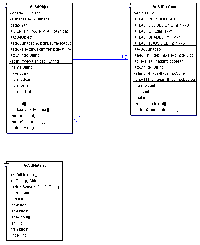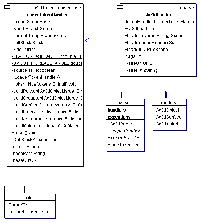AC3D Loader
Author: Ryan Wilhm (ryan@entrophica.com)
Ac3dLoader is an implementation of the Java 3D Loader interface
that is capable of loading model information from an AC3D file. This allows
the developer to incorporate geometric data modeled in the AC3D file into
their own Java programs using the Java 3D API. This loader does not support
loading behavior, since the AC3D modeling tool and file format do not provide
facilities for scripting automated behavior (such as animation). More
information on AC3D can be found at the AC3D home page listed at the end of
this page.
This loader only handles models generated with AC3D 3.0 or greater.
Code Outline
Ac3dLoader was originally written as two separate projects. The first project
was a general purpose AC3D file parser that loaded the flat file into a
hierarchical model for general-purpose use. The second project was the
Ac3dLoader implementation, which essentially just provides
mapping of the model generated in the parser to their Java 3D representation.
Although both projects have been merged into the single Ac3dLoader project,
the separate parsing functionality is still available.
Parsing
The AC3D file format is a token-based text file that consists of a header,
materials, and objects. With the exception of the header, each token is a
single word entity that describes the type of object (i.e., material,
grouping, surface, etc) and is followed by the data for the object. Objects
may have children (in other words, tokens can contain other tokens as data),
so a depth first traversal of the children when evaluating a token is a
consideration.
For the parser implementation, the command pattern was chosen to mimic the
token representation. Commands are implemented in a TokenHandler
object that is registered with the parser during setup. This effectively
decouples the parser from the data processing logic, since the parser has no
awareness of the either the tokens or their associated command implementation.
As long as the general structure of the file format does not change, implementing
new TokenHandler instances should accommodate any future updates
or needs without requiring modification to the parser. Additionally,
introspection is used to provide the token-to-command mapping automatically
in the TokenHandler base class. This reduces the amount of code
required to implement a TokenHandler, since this eliminates the
need to provide specialized handling code for each new
TokenHandler implementation. (It also eliminates the need to stub
code for unimplemented commands, since they are just ignored if a method to
command mapping cannot be determined by the introspection handler.)

The UML outline of the classes involved in the parser process
The above diagram illustrates the relationship between the
Ac3dParser and the TokenHandler instances. Upon
registration of the TokenHandler with the Ac3dParser
instance, versioning information is checked to ensure that the parser is
compatible with the given token handler. (Ac3dParser also
verifies the file is of the supported version when it parses the header,
too.) This is statically done now, and a better approach would be to allow
multiple LineTokenizer versions to support multiple file format
versions. (This implies that the Ac3d file header will always be consistent.)
LineTokenizer performs the work of extracting all of the tokens
contained within a line from an Ac3d file. Once the header is processed,
LineTokenizer steps through the file line by line. For each
command token (which is usually the first word in the line), the registered
TokenHandlerís handle() method is invoked with the
parsed data. This cycle continues until the end of the file is reached.
The TokenHandler base class contains the implementation of the
handle() method. This is convenient, because all subclasses that
extend TokenHandler are not responsible for handling commands when
they are issued. (As mentioned earlier, this is accomplished by introspection.)
Three models were chosen to map the geometry: Ac3dMaterial,
Ac3dObject, and Ac3dSurface. All three classes are
simply modeling beans, with accessors and mutators for accessing their
properties. Ac3dMaterial models the physical properties of an
object. This includes lighting, color, and so on. Ac3dObject
generally models a grouping. This can be a collection of other
Ac3dObject or Ac3dSurface instances. This is where
transformation and translation is usually applied, as well as texture
information.

The UML outline of the classes involved in the model loading process
Ac3dTokenHandlerBase is where the command and data tokens are
converted into a data model. This is an abstract class, since it does not do
anything meaningful with the models once they are constructed. The modeling
objects are generally acquired by accessing protected members by subclasses
that actually use the models. It is important to note that, in order to
subclass Ac3dTokenHandlerBase, any subclassed methods must call
their superclass method. Otherwise, the overridden method in the superclass
will not be called, and the data will not be modeled internally.
Finally, there are a few miscellaneous aspects that havenít been covered.
First, there is an interface in the parsing library called
OutputHandler. A user can register an OutputHandler
instance if they want to redirect any textual output
Ac3dLoader generates. The default for this is
ConsoleHandler, which just dumps output to the system console
using the System class. Second, there is a support class in the
org.j3d.loaders.ac3d.util package called ParserTest
that was used during development to verify that the file was being parsed
properly. This will dump the model data to the system console using the
DebugTokenHandler object.
The Java3D Loader
Since the infrastructure for handling Ac3d files is already in place, the
actual Ac3dLoader is merely a wrapper around a specialized
TokenHandler implementation (LoaderTokenHandler)
that maps the generic model objects to Java 3D objects. When the
Ac3dLoader is invoked, an Ac3dParser and
LoaderTokenHandler object is instantiated. The
Ac3dParser instance is populated with all of the information
required to find the file, and the
LoaderTokenHandler is populated with any special values (flags,
base path, etc) that they user has specified. The
LoaderTokenHandler is then registered with the
Ac3dParser.

The UML outline of the classes involved in the loader implementation
Within the Ac3d tool, it is possible to assign groups of points and surfaces
a human text name. This name is maintained during the parsing and mapping of
generic to Java 3D specific objects. This is useful when a developer wants to
perform some sort of manipulation of the rendering tree at a given branch.
(For example, to add behavior.)
To allow branch manipulation, the scene not compiled prior to return. Although
this yielded a much more optimized structure, it effectively removed the
ability to modify the structure. Compilation has subsequently been removed to
allow the individual the most flexibility when using the library. The downside
is that the user needs to manually force a recompile if you have no intentions
of changing the scene graph at a later time after loading.
Known Bugs and Limitations
- Introspection implementation is not fast. Currently, the introspection
occurs on each command invocation. This is not very efficient, and a more
optimal solution is to create a hash table mapping command names to methods
when the class is loaded. (I.e., in the static initialization block.)
- Geometry construction should be reviewed. Smooth surfaces arenít
facilitated, even when the crease angle is set. A sanity check is probably
in order.
- Only supports texture maps in format supported by JDK Toolkit. Even though
the Ac3d format specifies that the RGB file format is to be used for
storing and loading textures, the loader does not support file formats
outside of those readable by the JDK Toolkit. This is because the loader
delegates the work of loading images to the Toolkit.
Other References
- AC3D Homepage This is the home page for
the AC3D modeling tool. It is available for many different platforms,
including Windows, Linux, and Solaris. There is a lot of very useful
information contained within these pages pertaining to the use of AC3D,
as well.
- AC3D
File Format Specification
|


